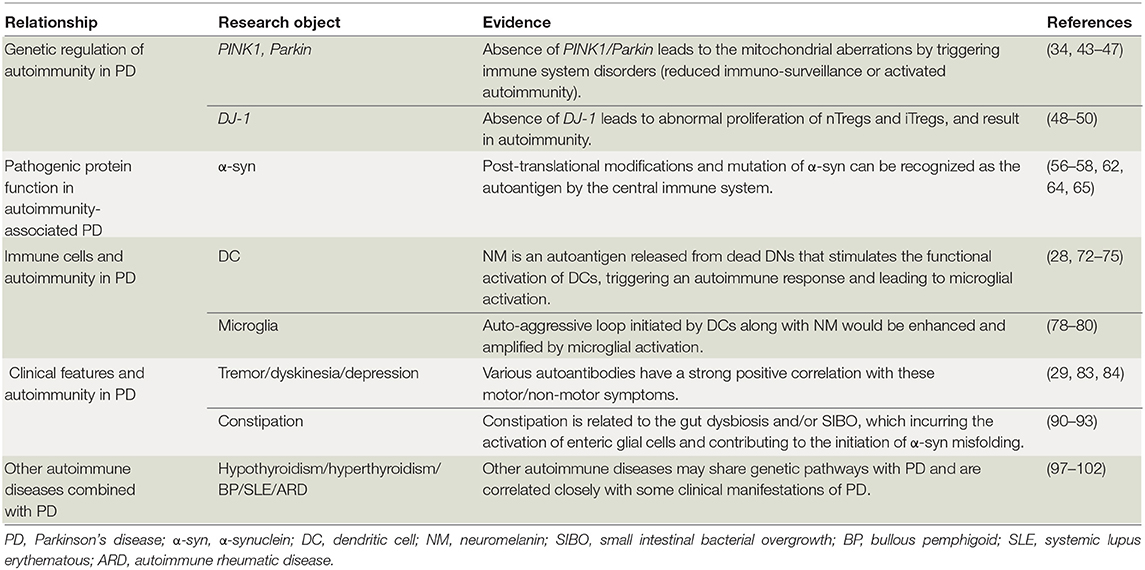The Challenge of the Pathogenesis of Parkinson's Disease: Is Autoimmunity the Culprit?
- 1Department of Neurology, Shanghai Eighth People's Hospital Affiliated to Jiang Su University, Shanghai, China
- 2Department of Neurology & Institute of Neurology, Rui Jin Hospital Affiliated to Shanghai Jiao Tong University School of Medicine, Shanghai, China
- 3East Hospital, Tong Ji University School of Medicine, Shanghai, China
A Corrigendum on
The Challenge of the Pathogenesis of Parkinson's Disease: Is Autoimmunity the Culprit?
by Jiang, T., Li, G., Xu, J., Gao, S., and Chen, X. (2018) Front. Immunol. 9:2047. doi: 10.3389/fimmu.2018.02047
In the original article, there was a mistake in Table 1 as published. The reference “Singh Y, Chen H, Zhou Y, Foller M, Mak TW, Salker MS, et al. Differential effect of DJ-1/PARK7 on development of natural and induced regulatory T cells. Sci Rep. (2015) 5:17723. doi: 10.1038/srep17723” should be inserted as reference 50. The corrected Table 1 appears below.
In addition, “Singh Y, Chen H, Zhou Y, Foller M, Mak TW, Salker MS, et al. Differential effect of DJ-1/PARK7 on development of natural and induced regulatory T cells. Sci Rep. (2015) 5:17723. doi: 10.1038/srep17723” was not cited in the article. The citation has now been inserted in the section Genetic Regulation of Autoimmunity in PD, paragraph two:
“In addition to these observations, DJ-1 (Parkinson's disease protein 7, PARK7) has also been reported to affect the development of natural Tregs (nTregs) and induced Tregs (iTregs, previously known as suppressor T cells). Mature Tregs with normal function, which modulate not only adaptive immunity but also innate immunity, are pivotal for maintaining thymic function, peripheral immune self-tolerance and immune system homeostasis. nTregs are generated in the thymus, while iTregs are derived from naïve CD4+ T cells encountering antigens in the peripheral organs. Both cell types are generally immunosuppressive through the suppression or downregulation of effector T cell proliferation (48). Their “self-check” function successfully prevents excessive effector cell reactions. On the other hand, the abnormal proliferation of both types of Tregs leads to the failure of self-/non-self-discrimination, resulting in autoimmune disease (49). Evidence reported by Singh et al. has demonstrated that DJ-1, one of the most classical key players responsible for PD pathogenesis, is strongly linked with neuroimmunology and multiple autoimmune responses in PD (50). In addition, DJ-1-deficient animal models have shown compromised iTreg induction, cell cycle progression, and cell survival and proliferation. DJ-1−/− iTregs are more proliferative, more susceptible to cell death signals and deficient in cell division compared with wild type counterparts, as analyzed by flow cytometry and Western blotting.”
The authors apologize for this error and state that this does not change the scientific conclusions of the article in any way. The original article has been updated.
References
Keywords: autoimmunity, Parkinson's disease, α-synuclein, autoimmune diseases, neuroimmunology
Citation: Jiang T, Li G, Xu J, Gao S and Chen X (2019) Corrigendum: The Challenge of the Pathogenesis of Parkinson's Disease: Is Autoimmunity the Culprit? Front. Immunol. 10:2242. doi: 10.3389/fimmu.2019.02242
Received: 20 March 2019; Accepted: 04 September 2019;
Published: 16 October 2019.
Edited and reviewed by: Herman Waldmann, University of Oxford, United Kingdom
Copyright © 2019 Jiang, Li, Xu, Gao and Chen. This is an open-access article distributed under the terms of the Creative Commons Attribution License (CC BY). The use, distribution or reproduction in other forums is permitted, provided the original author(s) and the copyright owner(s) are credited and that the original publication in this journal is cited, in accordance with accepted academic practice. No use, distribution or reproduction is permitted which does not comply with these terms.
*Correspondence: Shane Gao, gaoshan2009@tongji.edu.cn; Xu Chen, cxwp65@163.com
 Tianfang Jiang
Tianfang Jiang Gen Li
Gen Li Jun Xu
Jun Xu Shane Gao
Shane Gao Xu Chen1*
Xu Chen1*